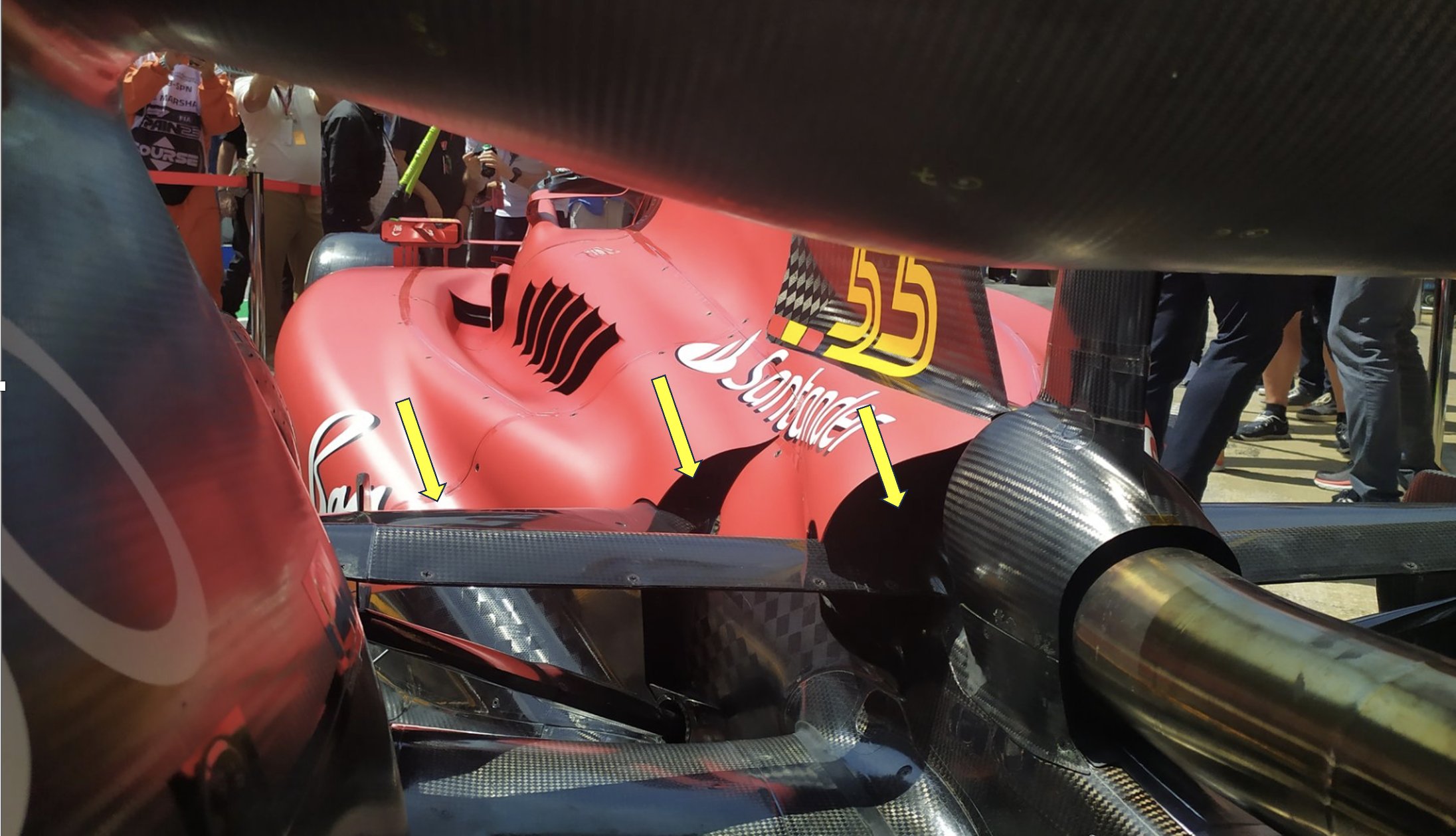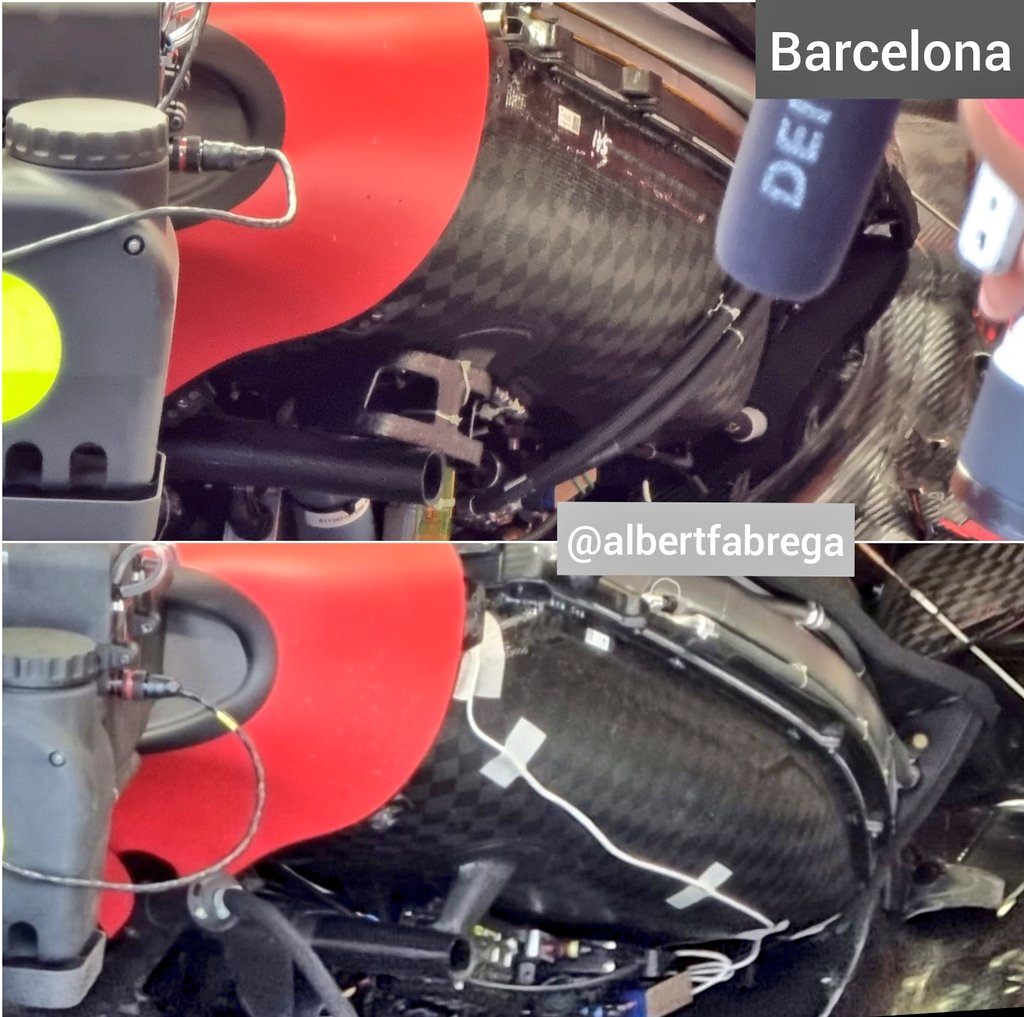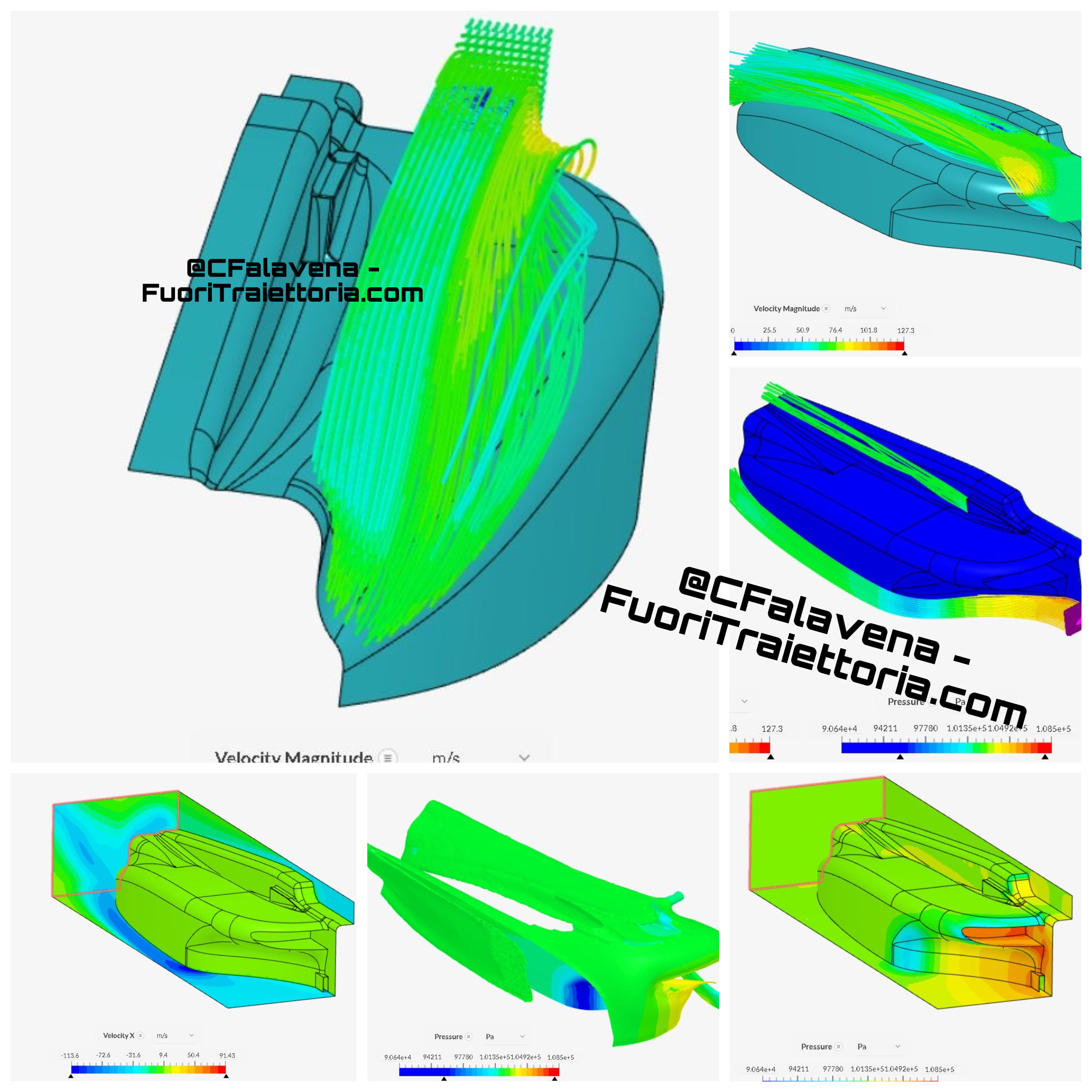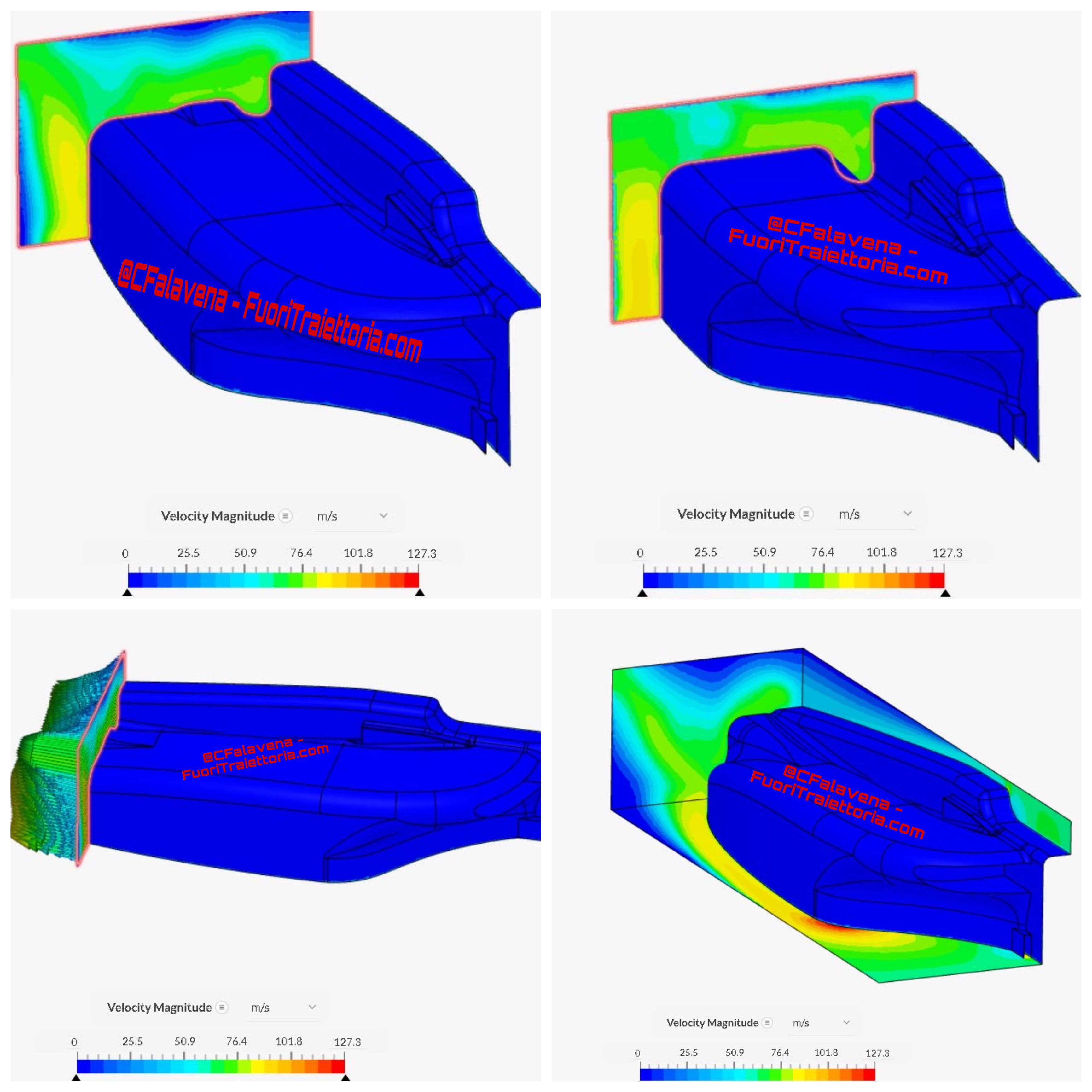
- Login or Register
No account yet? Sign up







Excellent post. Very informative.Vanja #66 wrote: ↑03 Jun 2023, 00:29Let's bust some latest myths, again
Why did things change so much, only to seemingly stay the same? They most definitely are not the same, even if the philosophy did not change a lot. The whole rear end of the SF-23 was designed for inwash flow, starting from pull rod suspension which would need to be a push rod design to optimise the downwash flow coming off the sidepods. Then there are both wishbones and other details sitting ahead of beam wing. If you mess this up, you mess the beam wing and the whole floor.
In my view, Ferrari had good reasons to re-extend the length of maximum-width section of sidepod undercut, otherwise they wouldn't have done so much work for this upgrade. Things are most likely in connection with rear tyre squirt management, to stop sudden changes in aero balance during the race and sometimes even in the same lap (as was reported). These mechanisms have certainly changed a lot for Ferrari after TD39 last year and clearly they are still suffering. A big part in all of this is also played by floor edge treatment, which is potentially the single biggest change on any car since last year. No doubt, new floor edge can only work well with these new sides and so the changes had to be made.
This might sound silly, but the "bulge" kind of just looks like what happens when you apply an R= fillet in CAD to an intersection of the pod and and offset surface of the SIS. It really is just a "not ideal but we have no choice" kind of solution imo. This "detail" would not exist if not for the SIS.Vanja #66 wrote: ↑03 Jun 2023, 00:29
Another thing worth pointing out is the SIS bulge, which grew from bubble to a very unappealing bulge. However, the bulge is actually much longer than the old bubble. This has a simple explanation, Ferrari engineers wanted to amplify some of its influence on the flow structures so they extended it. So it's not a bug, it's a feature! My best guess is that it really does have a lot to do with local outwash characteristics, even if it does look very unnatural and counter-intuitive.

Excellent! Thanks for that!Vanja #66 wrote: ↑03 Jun 2023, 00:29Let's bust some latest myths, again
New SF-23 Sidepods are NOT DOWNWASH Sidepods
Even if this was mentioned already, I want to go into more detail about this myth. Also a lesson on why you can't trust simple geometry to do eyeball CFD
First, let's take a more detailed look at what changed in sidepod flow conditioning and why. Starting from 2022 car, the 23 car was much tighter around the sidepod transition area and it's rightfully believed this was done to cut some chassis drag. However, now the extended section of same width is back - but moved a lot further back. Naturally, the whole undercut geometry is much smoother now, but not as smooth as RB19 of course.
https://i.ibb.co/xYX3H90/Fo7-OXgk-X0-AIEe4-D.jpg
If we now take a look at the shape of this full undercut line, we will see just how very different this line is. And, unlike RB18/19, it still retains Coke Bottle shape, although it is a lot wider than launch-spec SF-23. The widest point is not nearly as wide as before, which is curious since we know there was no change in radiator layout. Making this visual comparison made me wonder if there was any separation in this area on the outer sidepod while cornering, since the transition between outwash and inwash sections was very, very sharp and had very little curvature in Z-section.
Another thing worth pointing out is the SIS bulge, which grew from bubble to a very unappealing bulge. However, the bulge is actually much longer than the old bubble. This has a simple explanation, Ferrari engineers wanted to amplify some of its influence on the flow structures so they extended it. So it's not a bug, it's a feature! My best guess is that it really does have a lot to do with local outwash characteristics, even if it does look very unnatural and counter-intuitive.
https://i.ibb.co/b5Q0p2z/Fxn-EZhk-WIAAZ2-YE.jpg
Let's also take a look and compare new geometry to RB19. Top 3/4 view shows that the top surface on SF-23 is much longer than RB19. This suggest a much tighter transition of the downward ramp towards diffuser roof.
https://i.ibb.co/BwYdbv8/Fxo-Lg0-MWYAUp4n3.jpg
And when you look at how different this rear corner area is compared to RB19, you can start noticing there's a lot of things working very differently between these two designs:
https://i.ibb.co/mqfpJKH/Fxobq-Oj-WAAs-UXz-I.jpg
So let's take another look at the ramp geometry in 3D. RB19 has a ramp that starts going down right away and stays as wide as diffuser between rear wheels. New SF-23 sides are much tighter and can't possibly provide the same downwash effect as RB19. Also worth mentioning, top surface of RB19 sides is almost flat, but points downwards to ensure there's no "leakage" of downwash flow.
https://i.ibb.co/V29zbCc/dEKA2DH.jpg
Therefore, there can be no mistake, new SF-23 sides do not provide downwash flow towards diffuser ramp at all. Proof is in the flow vis, open for full-size picture since I made a smaller comparison to show everything on the same picture.
Comparing these flow vis photos and streak lines, we can see just how very different things are on Sauber and new Ferrari sidepods compared to RB19 sides. There is a very clear distinction between RB's downwash flow on diffuser ramp and inwash flows of Sauber and Ferrari. So, indisputably, Ferrari's new sidepods are in fact still inwash sidepods. Well, at least of the diffuser ramp surfaceArguably, this is where it counts the most, but it does also point us to a potential mixed overall flow direction in this area. It's impossible to say for sure since we have a lot of different vortex structures coming towards this area as well, but the inwash flow component is still there - that much is clear.
https://i.ibb.co/92HNSKp/zhou-flowvis.jpg
Why did things change so much, only to seemingly stay the same? They most definitely are not the same, even if the philosophy did not change a lot. The whole rear end of the SF-23 was designed for inwash flow, starting from pull rod suspension which would need to be a push rod design to optimise the downwash flow coming off the sidepods. Then there are both wishbones and other details sitting ahead of beam wing. If you mess this up, you mess the beam wing and the whole floor.
In my view, Ferrari had good reasons to re-extend the length of maximum-width section of sidepod undercut, otherwise they wouldn't have done so much work for this upgrade. Things are most likely in connection with rear tyre squirt management, to stop sudden changes in aero balance during the race and sometimes even in the same lap (as was reported). These mechanisms have certainly changed a lot for Ferrari after TD39 last year and clearly they are still suffering. A big part in all of this is also played by floor edge treatment, which is potentially the single biggest change on any car since last year. No doubt, new floor edge can only work well with these new sides and so the changes had to be made.
Very good, I would only change the title of the post in:Vanja #66 wrote: ↑03 Jun 2023, 00:29Let's bust some latest myths, again
New SF-23 Sidepods are NOT DOWNWASH Sidepods
Even if this was mentioned already, I want to go into more detail about this myth. Also a lesson on why you can't trust simple geometry to do eyeball CFD
First, let's take a more detailed look at what changed in sidepod flow conditioning and why. Starting from 2022 car, the 23 car was much tighter around the sidepod transition area and it's rightfully believed this was done to cut some chassis drag. However, now the extended section of same width is back - but moved a lot further back. Naturally, the whole undercut geometry is much smoother now, but not as smooth as RB19 of course.
https://i.ibb.co/xYX3H90/Fo7-OXgk-X0-AIEe4-D.jpg
If we now take a look at the shape of this full undercut line, we will see just how very different this line is. And, unlike RB18/19, it still retains Coke Bottle shape, although it is a lot wider than launch-spec SF-23. The widest point is not nearly as wide as before, which is curious since we know there was no change in radiator layout. Making this visual comparison made me wonder if there was any separation in this area on the outer sidepod while cornering, since the transition between outwash and inwash sections was very, very sharp and had very little curvature in Z-section.
Another thing worth pointing out is the SIS bulge, which grew from bubble to a very unappealing bulge. However, the bulge is actually much longer than the old bubble. This has a simple explanation, Ferrari engineers wanted to amplify some of its influence on the flow structures so they extended it. So it's not a bug, it's a feature! My best guess is that it really does have a lot to do with local outwash characteristics, even if it does look very unnatural and counter-intuitive.
https://i.ibb.co/b5Q0p2z/Fxn-EZhk-WIAAZ2-YE.jpg
Let's also take a look and compare new geometry to RB19. Top 3/4 view shows that the top surface on SF-23 is much longer than RB19. This suggest a much tighter transition of the downward ramp towards diffuser roof.
https://i.ibb.co/BwYdbv8/Fxo-Lg0-MWYAUp4n3.jpg
And when you look at how different this rear corner area is compared to RB19, you can start noticing there's a lot of things working very differently between these two designs:
https://i.ibb.co/mqfpJKH/Fxobq-Oj-WAAs-UXz-I.jpg
So let's take another look at the ramp geometry in 3D. RB19 has a ramp that starts going down right away and stays as wide as diffuser between rear wheels. New SF-23 sides are much tighter and can't possibly provide the same downwash effect as RB19. Also worth mentioning, top surface of RB19 sides is almost flat, but points downwards to ensure there's no "leakage" of downwash flow.
https://i.ibb.co/V29zbCc/dEKA2DH.jpg
Therefore, there can be no mistake, new SF-23 sides do not provide downwash flow towards diffuser ramp at all. Proof is in the flow vis, open for full-size picture since I made a smaller comparison to show everything on the same picture.
Comparing these flow vis photos and streak lines, we can see just how very different things are on Sauber and new Ferrari sidepods compared to RB19 sides. There is a very clear distinction between RB's downwash flow on diffuser ramp and inwash flows of Sauber and Ferrari. So, indisputably, Ferrari's new sidepods are in fact still inwash sidepods. Well, at least of the diffuser ramp surfaceArguably, this is where it counts the most, but it does also point us to a potential mixed overall flow direction in this area. It's impossible to say for sure since we have a lot of different vortex structures coming towards this area as well, but the inwash flow component is still there - that much is clear.
https://i.ibb.co/92HNSKp/zhou-flowvis.jpg
Why did things change so much, only to seemingly stay the same? They most definitely are not the same, even if the philosophy did not change a lot. The whole rear end of the SF-23 was designed for inwash flow, starting from pull rod suspension which would need to be a push rod design to optimise the downwash flow coming off the sidepods. Then there are both wishbones and other details sitting ahead of beam wing. If you mess this up, you mess the beam wing and the whole floor.
In my view, Ferrari had good reasons to re-extend the length of maximum-width section of sidepod undercut, otherwise they wouldn't have done so much work for this upgrade. Things are most likely in connection with rear tyre squirt management, to stop sudden changes in aero balance during the race and sometimes even in the same lap (as was reported). These mechanisms have certainly changed a lot for Ferrari after TD39 last year and clearly they are still suffering. A big part in all of this is also played by floor edge treatment, which is potentially the single biggest change on any car since last year. No doubt, new floor edge can only work well with these new sides and so the changes had to be made.
The more I compare Ferrari's solution with others (seen from above) the more I notice how much they resemble Williams, Alpine and Aston Martin. These teams basically took Ferrari's bathtub idea and then turned it into a very deep, steeply sloping "moat." Ferrari is now doing the same thing and Mercedes is going in that direction as well. Definitely a completely different path than Red Bull here as well. I'm curious to see if Ferrari's solution with the bathtub doesn't end up being something "better" than Red Bull's way. Time will tell, but in any case, more and more teams seem to be going this way now.Vanja #66 wrote: ↑03 Jun 2023, 00:29Let's bust some latest myths, again
New SF-23 Sidepods are NOT DOWNWASH Sidepods
Even if this was mentioned already, I want to go into more detail about this myth. Also a lesson on why you can't trust simple geometry to do eyeball CFD
First, let's take a more detailed look at what changed in sidepod flow conditioning and why. Starting from 2022 car, the 23 car was much tighter around the sidepod transition area and it's rightfully believed this was done to cut some chassis drag. However, now the extended section of same width is back - but moved a lot further back. Naturally, the whole undercut geometry is much smoother now, but not as smooth as RB19 of course.
https://i.ibb.co/xYX3H90/Fo7-OXgk-X0-AIEe4-D.jpg
If we now take a look at the shape of this full undercut line, we will see just how very different this line is. And, unlike RB18/19, it still retains Coke Bottle shape, although it is a lot wider than launch-spec SF-23. The widest point is not nearly as wide as before, which is curious since we know there was no change in radiator layout. Making this visual comparison made me wonder if there was any separation in this area on the outer sidepod while cornering, since the transition between outwash and inwash sections was very, very sharp and had very little curvature in Z-section.
Another thing worth pointing out is the SIS bulge, which grew from bubble to a very unappealing bulge. However, the bulge is actually much longer than the old bubble. This has a simple explanation, Ferrari engineers wanted to amplify some of its influence on the flow structures so they extended it. So it's not a bug, it's a feature! My best guess is that it really does have a lot to do with local outwash characteristics, even if it does look very unnatural and counter-intuitive.
https://i.ibb.co/b5Q0p2z/Fxn-EZhk-WIAAZ2-YE.jpg
Let's also take a look and compare new geometry to RB19. Top 3/4 view shows that the top surface on SF-23 is much longer than RB19. This suggest a much tighter transition of the downward ramp towards diffuser roof.
https://i.ibb.co/BwYdbv8/Fxo-Lg0-MWYAUp4n3.jpg
And when you look at how different this rear corner area is compared to RB19, you can start noticing there's a lot of things working very differently between these two designs:
https://i.ibb.co/mqfpJKH/Fxobq-Oj-WAAs-UXz-I.jpg
So let's take another look at the ramp geometry in 3D. RB19 has a ramp that starts going down right away and stays as wide as diffuser between rear wheels. New SF-23 sides are much tighter and can't possibly provide the same downwash effect as RB19. Also worth mentioning, top surface of RB19 sides is almost flat, but points downwards to ensure there's no "leakage" of downwash flow.
https://i.ibb.co/V29zbCc/dEKA2DH.jpg
Therefore, there can be no mistake, new SF-23 sides do not provide downwash flow towards diffuser ramp at all. Proof is in the flow vis, open for full-size picture since I made a smaller comparison to show everything on the same picture.
Comparing these flow vis photos and streak lines, we can see just how very different things are on Sauber and new Ferrari sidepods compared to RB19 sides. There is a very clear distinction between RB's downwash flow on diffuser ramp and inwash flows of Sauber and Ferrari. So, indisputably, Ferrari's new sidepods are in fact still inwash sidepods. Well, at least of the diffuser ramp surfaceArguably, this is where it counts the most, but it does also point us to a potential mixed overall flow direction in this area. It's impossible to say for sure since we have a lot of different vortex structures coming towards this area as well, but the inwash flow component is still there - that much is clear.
https://i.ibb.co/92HNSKp/zhou-flowvis.jpg
Why did things change so much, only to seemingly stay the same? They most definitely are not the same, even if the philosophy did not change a lot. The whole rear end of the SF-23 was designed for inwash flow, starting from pull rod suspension which would need to be a push rod design to optimise the downwash flow coming off the sidepods. Then there are both wishbones and other details sitting ahead of beam wing. If you mess this up, you mess the beam wing and the whole floor.
In my view, Ferrari had good reasons to re-extend the length of maximum-width section of sidepod undercut, otherwise they wouldn't have done so much work for this upgrade. Things are most likely in connection with rear tyre squirt management, to stop sudden changes in aero balance during the race and sometimes even in the same lap (as was reported). These mechanisms have certainly changed a lot for Ferrari after TD39 last year and clearly they are still suffering. A big part in all of this is also played by floor edge treatment, which is potentially the single biggest change on any car since last year. No doubt, new floor edge can only work well with these new sides and so the changes had to be made.
At first glance it looks like a hack job, but when you look at how bigger and wider it is than before, you realise they decided to use it to achieve something locally. Otherwise, it wouldn't be as wide as sidepods all of a sudden.AR3-GP wrote: ↑03 Jun 2023, 03:25This might sound silly, but the "bulge" kind of just looks like what happens when you apply an R= fillet in CAD to an intersection of the pod and and offset surface of the SIS. It really is just a "not ideal but we have no choice" kind of solution imo. This "detail" would not exist if not for the SIS.
Ferrari's new geometry is unique in how it combines different philosophies. However, the rear corner itself is mostly like Sauber but has even less of the actual ramp. In my view, the only reason they combined the shapes into such a ramp is because they wanted to achieve some pressure recovery there to cut the drag. Judging by comparative speeds at their FP1 fastest laps, Leclerc's car was 2kmh faster, so new parts may have increased the drag actually. Insufficient data to extract reliable conclusion, but this is what we have.Andi76 wrote: ↑03 Jun 2023, 10:38The more I compare Ferrari's solution with others (seen from above) the more I notice how much they resemble Williams, Alpine and Aston Martin. These teams basically took Ferrari's bathtub idea and then turned it into a very deep, steeply sloping "moat." Ferrari is now doing the same thing and Mercedes is going in that direction as well. Definitely a completely different path than Red Bull here as well. I'm curious to see if Ferrari's solution with the bathtub doesn't end up being something "better" than Red Bull's way. Time will tell, but in any case, more and more teams seem to be going this way now.

Indeed, the whole essence of the upgrade is to make the best out of the package they had on hand within the constraints of cost and schedule:AR3-GP wrote: ↑03 Jun 2023, 03:25This might sound silly, but the "bulge" kind of just looks like what happens when you apply an R= fillet in CAD to an intersection of the pod and and offset surface of the SIS. It really is just a "not ideal but we have no choice" kind of solution imo. This "detail" would not exist if not for the SIS.Vanja #66 wrote: ↑03 Jun 2023, 00:29
Another thing worth pointing out is the SIS bulge, which grew from bubble to a very unappealing bulge. However, the bulge is actually much longer than the old bubble. This has a simple explanation, Ferrari engineers wanted to amplify some of its influence on the flow structures so they extended it. So it's not a bug, it's a feature! My best guess is that it really does have a lot to do with local outwash characteristics, even if it does look very unnatural and counter-intuitive.


I posted my full reply in an appropriate topic here viewtopic.php?p=1137911#p1137911 so feel free to continue any further discussion there